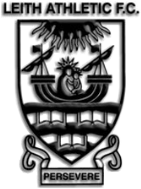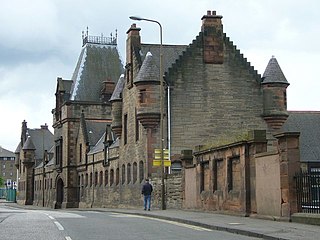
Leith Athletic Football Club is a football club based in the Leith area of Edinburgh, Scotland. They compete in the East of Scotland Football League, Conference A. First team matches are played at Peffermill 3G.
St Bernard's Football Club were a football club based in Edinburgh, Scotland. The club was established in 1878 and joined the Scottish Football League. They played at several different grounds before making the Royal Gymnasium Ground their long-term home. However, after having to sell it in 1943, the club was dissolved.
Brockville Park was a football stadium located on Hope Street in Falkirk, Scotland, 0.25 miles (0.4 km) north-west of the town centre. It was the home of Falkirk F.C. from 1885 until the end of 2002–03 Scottish football season. The record attendance at Brockville Park was 23,100 on 21 February 1953 in a match against Celtic. The stadium has since been replaced with a Morrisons supermarket. An old turnstile is on display next to the supermarket's car park.

Powderhall is an area lying between Broughton Road and Warriston Road in the north of Edinburgh, the Scottish capital. Until recently it was best known for Powderhall Stadium, a greyhound racing track, which has now closed. The stadium also played host to motorcycle speedway racing from 1977 to 1995, as home to the Edinburgh Monarchs, who have since relocated to Armadale. The Powderhall Sprint, first held in 1870, was a professional footrace with handicapping of the runners. It continues, since 1999, as the New Year Sprint and is now held at Musselburgh Racecourse.

Shawfield Stadium is a closed greyhound racing, football and speedway venue in the Shawfield district of the town of Rutherglen, South Lanarkshire, Scotland, located close to the boundary with Glasgow.
Tontine Park was a football ground in Renton, West Dunbartonshire, Scotland. It was the home ground of Renton F.C. from 1878 until 1922, including their time in the Scottish Football League.

Powderhall Stadium formerly the Powderhall Grounds was a greyhound racing track in Edinburgh, Scotland. It was located on Beaverhall Road, in the Powderhall (Broughton) area of northern Edinburgh, beside the Water of Leith. The track closed in 1995 and the site is now a housing estate.
The Marine Gardens was an entertainment complex located in the Portobello area of Edinburgh, Scotland. Opened in 1909 as a pleasure garden and amusement park on the shores of the Firth of Forth, most of its original attractions apart from the ballroom were removed following military use of the site during the First World War. The complex also included a stadium which was used during the interwar period for football, greyhound racing and speedway. It was the home venue of Scottish Football League teams Leith Athletic (1928–1936) and Edinburgh City. The Marine Gardens closed down permanently in 1939 after again being taken over by the military, with the area being redeveloped after the Second World War.
Beechwood Park, initially known as Bank Park, was a football ground in the Leith area of Edinburgh, Scotland. It was the home ground of Leith Athletic during their first seven seasons in the Scottish Football League (SFL).
New Logie Green was a football ground in the Powderhall area of Edinburgh, Scotland. It was the home ground of St Bernard's from 1889 until 1899, and was also used to host the 1896 Scottish Cup final, the only time the Scottish Cup final has been played outside Glasgow. The ground was named after a nearby mansion.
Old Logie Green was a football ground in the Bonnington area of Edinburgh, Scotland. It was the home ground of Leith Athletic and St Bernard's between 1904 and 1926, both having previously played at the neighbouring New Logie Green ground.
Hawkhill was a cricket and football ground in the Leith area of Edinburgh, Scotland. It was the home ground of Leith Athletic.
Chancelot Park was a football ground in the Leith area of Edinburgh, Scotland. It was the home ground of Leith Athletic from 1900 until 1904 and again from 1919 until 1924.
North End Park, also known as Colliers Den, is a disused playing field in Cowdenbeath. Between 1888 and 1917 the site was a football ground and the home venue of Cowdenbeath F.C. It was later the home ground of Fife amateur club Hearts of Beath and was also used as a greyhound racing stadium from the 1930s until the 1970s, before the site was sold for development.
Clydeholm was a football and greyhound racing stadium in Clydebank, Scotland. It was the home ground of the first Clydebank F.C. to play in the Scottish Football League.
Volunteer Park is a football ground in Armadale, West Lothian, Scotland. It is the home ground of Armadale Thistle, and was used by several of the town's previous clubs, including Armadale F.C., who played Scottish Football League matches there between 1921 and 1933. The ground also hosted greyhound racing during the 1930s.
Raploch Park, also known as the Larkhall Greyhound Stadium, was a football ground and greyhound racing stadium in Larkhall, Scotland. It was the home ground of Royal Albert.
Celtic Park was a football ground in Glasgow, Scotland. It was the home ground of Celtic from 1888 until they moved to the site of the modern Celtic Park in 1892. The ground staged an international match between Scotland and Ireland in 1891.
City Park was a football ground in Edinburgh, Scotland. The ground was used by several clubs, including Edinburgh City, Ferranti Thistle, Hibernian reserves, Spartans and Craigroyston.
Stenhouse Stadium was a greyhound racing track and trotting track in Edinburgh.





